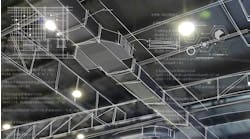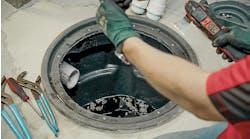WE DISCUSSED THE potential of waste heat recovery as an alternative to conventional heat sources for powering commercial snow-melt systems in last month's column (November, pg. 40). In this month's column, we'll begin looking at solar thermal energy as an alternative to conventionally heated systems.
One of my earliest exposures to the idea of turning excess solar radiation into snow-melt energy came in one of my classes from a student who had completely retrofitted his home with hydronic radiant floor heat. During the course of construction, he also added an oversized two-car garage. In the floor of this garage, with its excessively deep center slab and extra insulation below the slab to act as thermal mass and heat storage, the student had incorporated PEX tubing. The walls of the garage were 2-by-6 construction and insulated to an R-19, with the roof being R-30.
He then covered the whole south side of the garage with a lean-to style of flat-plate solar collectors. In addition to this, he incorporated PEX tubing and insulation into the concrete slab on the north side of the garage, where the automobiles would be parked and brought into the garage. When I asked why he was providing such palatial digs for his cars, he told me that he wasn't doing it for the cars as much as he was doing it for the red earthworms that he was raising in bins along the sides of the garage. He actually had a business based on vermicomposting earthworms. The solar collectors and radiant floors were to accommodate his worm production facilities. Of course, climbing into a warm car had its side benefits.
Operation is quite simple. When the solar collectors are hotter than 90°F, pumps turn on and solar-heated glycol circulates between the solar panels and the PEX circuits buried in the floor of the garage. When the actual garage temperature exceeds 60°F and the solar collectors are still warm, then a two-way diverting valve directs the excess solar capacity out to the northfacing parking area that is typically in shadow for the majority of the winter season. The whole hydronic/solar system is filled with a 50% solution of propylene glycol.
When I asked him how well his system had been working, he said that earthworms cannot handle temperatures of less than 40°F or they begin to die. In three years of operation since construction, he had not lost a worm and he had never had to shovel snow or ice out of the shadows of his garage on the north side of the building. Fairly impressive for a system whose parasitic cost of operation is less than a 100W bulb during daylight hours!
This got the gears rolling in my head. Why not take advantage of one of the cleanest energy sources to strike the face of the earth? After all, solar has been the default snow-melt system since the invention of paved surfaces.
One of the biggest problems facing the solar industry is that demand and available energy don't coincide, meaning, when you need it the most, you get it the least, and when you need it the least, you get it the most. If you don't have any means of dissipating the solar heat in summer, it becomes problematic for fluids and flat-plate solar collectors stagnating at temperatures approaching 350°F at the absorber.
A solar array can be maintained at reasonable operating temperatures in the summer by dumping the excess summer radiation into the snow-melt system. Depending upon how much the array is oversized, there is the real possibility that excess Btu may be available even during the winter months.
Obviously, I am speaking of our solar availability here in sunny Colorado, and, as they say in the automobile business, "Your mileage may vary." In Colorado, we get an average of 300 days of sunshine, as compared to Washington, where they average only 200 days of sunshine. Too many black clouds following politicians around? In any case, you can see that you'll need to check solar availability in your climate before making a decision whether this might be an option. Summer stagnation is still a problem, regardless of your locale.
I have seen this system work, and the benefits are obvious. With the reintroduction of solar thermal collectors ("More heat, less fuel," November, pg. 24), this is an area that warrants thinking outside the box. What the heck, the energy is relatively free and plentiful. We might as well use it.
In closing this last column of 2006, I'd like to take a moment to thank all those people who are spread out around this wonderful globe protecting our rights as free citizens. I'd also like to thank their families for allowing their loved ones to perform this necessary job, and ask all our readers to say a prayer of thanks and protection for those people serving our country. Merry Christmas, Happy Chanukah and tune in next year as we continue our journey towards a cleaner, safer happier environment. Until then, Happy Hydronicing!
Mark Eatherton is a Denver-based hydronics contractor. He can be reached via e-mail at [email protected] or by phone at 303/778-7772.

